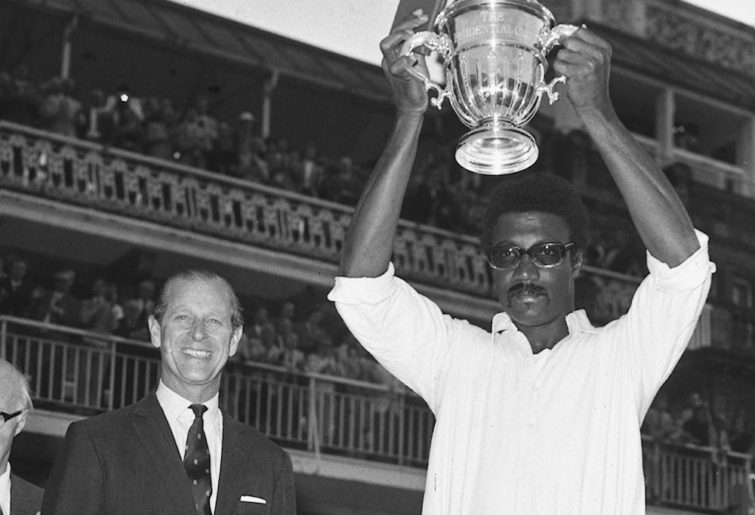Cricket’s law 43.1 states ‘win the toss and bat. If unsure, think about it, then bat anyway’. This series of articles will investigate what can happen when a captain disregards this unwritten law.
Part 1 will review those occasions when Australia was sent in and either dismissed cheaply or lost many wickets early to seemingly vindicate the opposing captain’s choice, yet recovered and won the match. Part 2 will summarise those instances when the opponent’s decision to field first backfired immediately and spectacularly.
These articles have been prompted by other Roarers’ recent comments regarding the relative value of runs scored in each innings of a match.
One of cricket’s greatest challenges is to prosper when sheer luck creates conditions for an opponent to exploit. Having to bat on a green top, or field in 40-degree heat, is sometimes simply the result of a fortuitous call of heads or tails.
Various measures have been tried in order to reduce a toss’s influence on a match. Five years ago the County Championship dispensed with the toss, instead giving the visiting captain the choice of innings.
Before that Cricket Australia introduced a four-quarter format for its domestic one-day competition. And the International Cricket Council currently mandates virtual roads for white-ball internationals.
It was once almost unheard of to send Australia in. Between 1927 and 1953, it didn’t happen at all. During Test cricket’s first 89 years until 1965 it happened only 13 times, and Australia lost just one of those games.
In the days before pitch covers, respecting law 43 was understandable. There are many examples of a pre-WWII team struggling to a modest score, then making hay while the sun shone on a soft but drying pitch after overnight rain.
Since then, sending in an opponent has become a safer tactic. The West Indies’ Clive Lloyd normalised the practice, and others soon followed suit.

(Photo by PA Images via Getty Images)
Australia was sent in seven times during the 1960s, doubling to 13 times in the 1970s, and then doubling again to 27 times in the 1980s.
Overall, Australia has been invited to bat 106 times. Its record is currently 52 wins, 30 draws and just 23 losses, with one match abandoned.
Only South Africa has a better ratio, with 23 wins and just eight losses from the 54 occasions it has been sent in. At the other end of the spectrum is Bangladesh, which has been invited to bat 32 times and won just once.
Australia has been invited to bat 60 times at home, 13 when in England, 11 in the West Indies and nine in New Zealand. English captains have used the tactic 30 times, and New Zealanders and West Indians 19 apiece.
Even with favourable ground conditions, inviting an opponent to bat first is not a guarantee of success. The inserted team can be good enough to end the match’s first day in trouble yet prevail over four innings. It might even end that opening day well on top.
Just a few teams have enjoyed regular success employing the tactic against Australia. South Africa’s record is the only positive one, with five wins and only three losses. The West Indies’ is seven wins and eight defeats, and that of New Zealand four wins and six losses.
In fact while Australia has lost 25 per cent of its 834 matches to date, it has a better record when sent in to bat. Just 22 per cent of those 105 instances have ended in defeat.
So far the only decade to buck the trend has been the 1980s. During that period the team was invited to bat first 27 times, and recorded ten losses and just seven wins. Weak Australian batting and strong opposing fast bowling were clear contributing factors.
Described below are the seven occasions when Australia was sent in and either dismissed cheaply or lost many wickets early on the match’s first day, but recovered to achieve a deserved victory.
Australia versus England, the MCG, 1976-77
Australia was sent in and dismissed for just 138, yet won the match by 45 runs.
The game was the one-off Centenary Test commemorating the 100th anniversary of what became recognised as the inaugural match. England had just completed its first series victory in India since 1933-34. The home side had drawn a home series with Pakistan, but was missing Jeff Thomson due to injury.
Visiting captain Tony Greig called correctly and invited the home side to bat first. Australia slumped to 5-51, before recovering slightly to tally 138. Opening batsman Rick McCosker suffered a broken jaw at the hands of Bob Willis. Australian captain Greg Chappell batted for almost four hours to score 40 runs, and wrote later that:
“The game probably came about 36 hours too soon for the pitch. From memory it was a bit cloudy around the lead-up to the game and he [curator Bill Watt] might have just got his timing out a little bit.”

(Photo by Matt King – CA/Cricket Australia/Getty Images)
England reached 1-29 by stumps. It had realistic expectations of achieving a significant first-innings lead on a steadily improving pitch.
However on the match’s second day Australia fought back superbly in the field. The visitors managed just 95. Dennis Lillee and Max Walker bowled almost unchanged, to claim 6-26 and 4-54 respectively.
At the close of play the game was evenly poised. The home side’s score was 3-104, for an overall lead of 147 runs. It then batted for the entire following day to reach 8-387, with McCosker heroically batting at number ten in support of centurion Rod Marsh.
Eventually Chappell declared his team’s innings at 9-419 to set England an imposing 463-run victory target. It batted superbly and was ultimately dismissed for 417. Lillee claimed 5-139 for a match haul of 11-165. The visitors’ Derek Randall was awarded man of the match for his almost-decisive innings of 174.
The game’s final margin of 45 runs was identical to that of the first Test ever played. After 145 years of Test cricket, they are still the only two matches to have been decided by that number of runs.
Australia versus England, the SCG, 1907-08
Australia was sent in and dismissed for just 137, then conceded a 144-run first-innings lead, yet won the match by 49 runs.
Visiting skipper Arthur Jones called truly and invited the home side to bat first on a pitch that was difficult to bat on due to preceding rain. It managed just 137, with SF Barnes claiming 7-60.
England fared much better at the batting crease. By stumps it had reached 1-116, with legendary batsmen Jack Hobbs and George Gunn undefeated on 65 and 50 respectively. The visitors subsequently extended their innings to 281, with Gunn scoring an undefeated 122.
When Australia batted again in the face of a large deficit, England paid a heavy price for missing a difficult catch at short mid-on from Victor Trumper when he had scored a single run. He subsequently played a superb innings of 166 from 249 deliveries, which included 18 boundaries.

(Photo by Hulton Archive/Getty Images)
Teammates Syd Gregory and captain Monty Noble played key roles in minimising their team’s first-day collapse, and assisting Trumper to cement the home side’s advantage. Gregory scored 44 and 56, while Noble contributed 35 and 34. Australia ultimately reached 422 for an overall lead of 278.
The visitors then rallied from 5-57 on a pitch deteriorating after further rain. They reached 229 but still lost the match by 49 runs. Australia duly recorded a 4-1 series victory and regained the Ashes.
New Zealand versus Australia, Auckland, 1973-74
Australia was sent in and dismissed for just 221, yet won the match comfortably within three days by 297 runs.
After their inaugural meeting in 1945-46, the two sides would not play each in Australia or again in New Zealand for another 27 years. The home side began this series’ last game leading it by a 1-0 margin.
The Wisden Almanack’s match report states: “The watering of the pitch was apparently continued too late in its preparation and with autumn dew and an earlier start (10:30am) to counter failing light encountered at Auckland at this time of the year, it was wet when the Test began.”
Visiting captain Ian Chappell called incorrectly. Keith Stackpole was caught from the match’s first ball, a head-high full toss. Greg Chappell and Ian Davis also fell for ducks. Ian Chappell later wrote:
“I arrived at the toss to discover a pitch drowned by a hose, and when the flick of the florin favoured New Zealand captain Bev Congdon, I uttered a familiar four-letter expletive. Feeling no need for sympathy, Congdon was unmoved and asked us to bat first.
“My intention was to attack from the outset with a view to declaring at lunch to ensure New Zealand had to bat with the pitch still wet. However, this ploy put us in early trouble and when (Doug) Walters entered the fray we were 4-37.
“New Zealand probably expected Walters to start quietly, have a look at the bowling and assess the conditions, but he unnerved them by playing his natural game.
“Walters was a great cutter and on this pitch where the ball bounced steeply but slowly, he employed the shot regularly. He was also a wonderful on-driver, utilising his ‘come-to-attention shot’, where he abruptly brought his back foot up to meet the front one, as though clicking the heels of his army boots.
“Walters’ counter attack, mounted with Australia in a parlous position, turned the match and wrested the initiative from a rampant New Zealand team. Just one of many occasions when Walters’ aggressive play from number six helped Australia win a Test.”
Walters’ undefeated 104 from just 138 balls was one of many similar innings by him. His career record in first innings when Australia had been sent in was a superb 625 runs at 104.16.
In the time remaining before stumps, the visitors reduced New Zealand to 8-85. The following morning they dismissed the home side for 112. Australia then scored 346 in its second innings despite Stackpole completing a pair in what would prove to be his final Test.
New Zealand needed 456 for victory and could register only 158. The result enabled the visitors to draw the series.
Australia versus England, the MCG, 1901-02
Australia was sent in and dismissed for just 112, yet won the match by 229 runs. On the game’s first day, an astonishing 25 wickets fell.
England’s team was the last privately organised one to tour Australia. Captain Archie MacLaren selected Lancashire League bowler SF Barnes on the basis of a single net session.
After days of persistent rain, MacLaren called truly and invited the home side to bat first on a treacherous pitch. Barnes and Colin Blythe bowled unchanged to dismiss the home side for just 112, taking 6-42 and 4-64 respectively. Reggie Duff top scored on debut with 32.

(Photo by Ryan Pierse/Getty Images)
England could score only 61 from 15.4 overs in reply, as the impossible batting conditions continued. Renowned hitter Gilbert Jessop top scored with 27 from just 15 deliveries. Monty Noble took 7-17, the last five of them in the space of 12 balls.
Australia commenced its second innings with a 51-run lead and plenty of time still remaining in the first day’s play. Captain Joe Darling virtually reversed his team’s batting order, saving his best batsmen for the following day.
The home side went to stumps at 5-48, its lead a mere 99 runs. Barnes took four of the wickets to fall, to complete a ten-wicket haul on the day. But crucially Australia’s last five batsmen were now Clem Hill, Victor Trumper, Warwick Armstrong, Duff and Noble.
On the match’s second day, conditions improved as expected. Hill scored 99, the first of his three consecutive 90s in Test cricket. Duff scored 104 batting at number ten, and shared a 120-run last-wicket partnership with Armstrong. Their team ended play at 9-300 and was eventually dismissed the following morning for 353. Barnes claimed 7-121 for match figures of 13-163.
The visitors needed 405 to win, and could manage only 175. Noble took 6-60 for match figures of 13-77. Australia levelled the series at 1-1, and went on to win it by a 4-1 margin.
Australia versus India, Adelaide Oval, 1991-92
Australia was sent in and dismissed for just 145, then conceded an 80-run first-innings lead, yet won the game by 38 runs.
Australia led the five-match series by a 2-0 margin. The preceding third Test at the SCG had been drawn with highlights including Ravi Shastri’s 206, teenager Sachin Tendulkar’s undefeated 148 and debutant Shane Warne’s 1-150.
Visiting captain Mohammad Azharuddin called correctly and invited Australia to bat, and was rewarded with regular wickets. Opening bowlers Kapil Dev and Manoj Prabhakar took 3-33 and 2-55 respectively. Tendulkar bowled Mark Taylor and had captain Allan Border caught behind to return figures of 2-10.

(Credit: Ben Radford/Allsport via Getty Images)
Despite Dean Jones’ innings of 41, the home side struggled to reach just 145 from 66.4 overs. By stumps India had scored 2-45 in reply. With its deficit reduced to 100 runs and eight wickets still in hand, the side would have been very satisfied with its performance.
On the match’s second day India was reduced to 6-70 before rallying to reach 225 and secure an 80-run lead. Craig McDermott took 5-76, while Dev led his side’s recovery with an 83-ball 56.
By stumps the home side was back in charge thanks to a 221-run second-wicket partnership between centurions Taylor and David Boon. On the following day it extended its innings to 451, and was able to set India 371 for victory.
Although Azharuddin then produced a captain’s knock of 103, it fell 38 runs short. McDermott claimed 5-92 for a ten-wicket match haul and the man of the match award. Warne returned figures of 0-18 and 0-60 to extend his career-to-date bowling average to 228.00.
India versus Australia, Kolkata, 1956-57
Australia was sent in and dismissed for just 177, yet won the match by 94 runs.
On its way home from the unsuccessful Ashes tour of 1956, Australia contested four Tests on the sub-continent. This was the last of them.
Visiting skipper Ian Johnson called incorrectly and his team was sent in to bat. India had selected three slow bowlers, to take maximum advantage of a pitch expected to provide considerable turn.
Spin bowlers took 35 of the game’s 39 wickets. India’s solitary medium-pace bowler delivered just four overs during the entire match.
Australia laboured to a modest 177. Peter Burge top scored with 58 in three hours, while off spinner Ghulam Ahmed claimed 7-49. India went to stumps at 0-15, to be well placed for a long first innings and a significant lead.
On the match’s second day, the visitors fought back strongly. After overnight rain delayed play for an hour, they reduced the home side to 8-135 at stumps. The following morning India was dismissed for 136, with leg spinner Richie Benaud taking 6-52.
Australia then built on its useful lead and declared at 9-189 to set India a modest but challenging victory target of 231. The home side’s opening batsmen survived what remained of the third day’s play to end it at 0-12.
On the match’s fourth day each of India’s first five batsmen was dismissed for between 20 and 28, while the remaining six amassed just five runs in total. India’s innings duly closed at 136, to deliver Australia a 94-run win.
Benaud took 5-53 for match figures of 11-105, while off spinner Jimmy Burke claimed 4-37 with an action that would be unlikely to pass muster nowadays.
This is just one of two instances of Australia ever being sent in to bat in India. The other occasion was in 1964-65 and also in Kolkata. That rain-affected match’s result was a draw.

(Photo by Simon Cross/Getty Images)
Australia versus Pakistan, the WACA, 2004-05
Australia was sent in and reduced to 5-78, yet subsequently gained a 202-run first-innings lead, and then won the game by 491 runs.
Visiting captain Inzamam-ul-Haq inserted the home side on a fast, bouncy pitch. He was rewarded when it slumped to 4-72 at lunch, then 5-78 shortly after the interval.
Shoaib Akhtar took three of those wickets, and Mohammad Sami the other two. Pakistan’s wicketkeeper Kamran Akmal stood back 30 yards for Shoaib, who struck Justin Langer several times.
Perth favourites Langer and Adam Gilchrist then launched a strong counter attack, adding 152 runs in just 28.3 overs. After Gilchrist fell for 69 from just 78 deliveries, Langer steered his side to 8-357 at stumps.
The following morning Langer was the last batsman dismissed, for 191 from 280 balls in a total score of 381. Pakistan replied with just 179, with Michael Kasprowicz claiming 5-30.
Australia declined to enforce the follow-on and declared its second innings at 5-361. The team’s third home-town player Damien Martyn scored a century, while Langer and Ricky Ponting contributed nineties.
Pakistan faced an unachievable victory target of 564 runs. It collapsed for 72 with Glenn McGrath claiming 8-24.
Team coach Bob Woolmer told the media afterwards that: “It was an abject performance, very disappointing. I can’t speak for them, but obviously there’s an element of the mental confusion and the mental awe in this performance.”



































































































